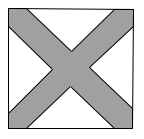2007 AMC 10A Problems/Problem 19
Problem
A paint brush is swept along both diagonals of a square to produce the symmetric painted area, as shown. Half the area of the square is painted. What is the ratio of the side length of the square to the brush width?
![]()
Solution
Solution 1
Without loss of generality, let the side length of the square be ![]() unit. The area of the painted area is
unit. The area of the painted area is ![]() of the area of the larger square, so the total unpainted area is also
of the area of the larger square, so the total unpainted area is also ![]() .
Each of the
.
Each of the ![]() unpainted triangle has area
unpainted triangle has area ![]() . It is easy to tell that these triangles are isosceles right triangles, so let
. It is easy to tell that these triangles are isosceles right triangles, so let ![]() be the side length of one of the smaller triangles:
be the side length of one of the smaller triangles:
![]()
The diagonal of the triangle is ![]() . The corners of the painted areas are also isosceles right triangles with side length
. The corners of the painted areas are also isosceles right triangles with side length ![]() . Its diagonal is equal to the width of the paint, and is
. Its diagonal is equal to the width of the paint, and is ![]() . The answer we are looking for is thus
. The answer we are looking for is thus ![]() . Multiply the numerator and the denominator by
. Multiply the numerator and the denominator by ![]() to simplify, and you get
to simplify, and you get  or
or  which is
which is ![]() .
.
Solution 2
Again, have the length of the square equal to ![]() and let the width of each individual stripe be
and let the width of each individual stripe be ![]() . Note that you can split each stripe into two rectangles and two isosceles right triangles at the corners. Then the area of each stripe is
. Note that you can split each stripe into two rectangles and two isosceles right triangles at the corners. Then the area of each stripe is ![]() . The area covered by the two total stripes is twice the area of one stripe, minus the area in the intersection of the stripes, which is a square with side length
. The area covered by the two total stripes is twice the area of one stripe, minus the area in the intersection of the stripes, which is a square with side length ![]() . This area is equal to
. This area is equal to ![]() So:
So:
![]() .
.
By the quadratic formula,

It's easy to tell that ![]() is too large, so
is too large, so ![]() . We want to find
. We want to find ![]() , and
, and ![]() . Multiply the numerator and the denominator by
. Multiply the numerator and the denominator by ![]() ,
,
![]()
See also
| 2007 AMC 10A (Problems • Answer Key • Resources) | ||
| Preceded by Problem 18 |
Followed by Problem 20 | |
| 1 • 2 • 3 • 4 • 5 • 6 • 7 • 8 • 9 • 10 • 11 • 12 • 13 • 14 • 15 • 16 • 17 • 18 • 19 • 20 • 21 • 22 • 23 • 24 • 25 | ||
| All AMC 10 Problems and Solutions | ||
The problems on this page are copyrighted by the Mathematical Association of America's American Mathematics Competitions. ![]()










